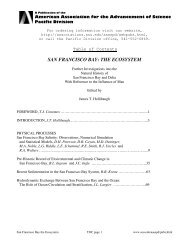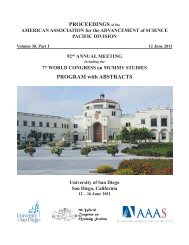Vol 31, Part I - forums.sou.edu ⢠Index page - Southern Oregon ...
Vol 31, Part I - forums.sou.edu ⢠Index page - Southern Oregon ...
Vol 31, Part I - forums.sou.edu ⢠Index page - Southern Oregon ...
Create successful ePaper yourself
Turn your PDF publications into a flip-book with our unique Google optimized e-Paper software.
ABSTRACTS – Contributed Posters<br />
inhibited cell proliferation of both SCC1 and SCC23 cells.<br />
Cell cycle analysis showed that the inhibitors affected cell<br />
cycle progression of both SCC1 and SCC23 similarly in<br />
that the percentage of cells in S and G2 phase increased at<br />
the expense of those in G1. Conclusion: Based on our data,<br />
JMJD2 inhibitors A70 and SD70 can effectively inhibit SCC<br />
proliferation and can possibly be a target for the treatment of<br />
head and neck cancers.<br />
165 Role of IL-6 Family Cytokines in Breast Tumor Cell<br />
Expression of VEGF, MADHURI NANDAKUMAR*,<br />
DANIELLE HEDEEN and CHERYL JORCYK<br />
(Department of Biological Sciences, Boise State<br />
University, 1910 University Drive, Boise, ID-8372;<br />
madhurinandakumar@u.boisestate.<strong>edu</strong>).<br />
OSM is a multifunctional IL-6 family cytokine produced<br />
by many cells including human T-Lymphocytes, neutrophils,<br />
macrophages and monocytes. Studies from our lab and others<br />
provide evidence that OSM plays an important role in tumor<br />
progression through stimulation of detachment, invasion invitro<br />
and induction of the pro-angiogenic factor, vascular<br />
endothelial growth factor (VEGF). Our current studies were<br />
designed to determine differential secretion of VEGF in<br />
breast cancer cells induced by IL-6 family cytokines. Our<br />
results indicate an increased secretion of OSM-induced<br />
VEGF. Effect of these inflammatory cytokines on endothelial<br />
tube formation and neo-vascularisation, in vivo, were also<br />
measured. Our results also provide insight into the effects of<br />
inflammatory cytokines on inducing important transcription<br />
factors. These results may provide important insight into<br />
understanding signaling pathways involved in cytokinemediated<br />
VEGF induction.<br />
Funded by NIH R15CA137510, ACS RSG-09-276-01-CSM, Susan G<br />
Komen for the cure KG100513, and NIH/NCRR P20RR016454.<br />
166 Parathyroid Hormone Related Protein (PTHrP)<br />
Regulates Expression Of Estrogen Receptor In Bone And<br />
Breast, KELSEY BRUCH, HANNAH DYAR* and<br />
MINOTI HIREMATH (Department of Biological Sciences,<br />
Boise State University, 1910 University Drive, MS1515,<br />
Boise, ID 83725; Hannah.dyar@gmail.com, kelseybruch@u.<br />
boisestate.<strong>edu</strong> and minotihiremath@boisestate.<strong>edu</strong>).<br />
Parathyroid Hormone Related Protein Protein (PTHrP)<br />
acts as a local cell-signaling factor to regulate mammary<br />
development in the embryo. PTHrP is required for formation<br />
of the mammary mesenchyme, which is a collection of<br />
stromal cells that condensed around the invading epithelial<br />
component of the mammary gland. Mammary mesenchymal<br />
cells express specific proteins including estrogen receptor<br />
(ER). ER expression is abolished in PTHrP -/- mice and<br />
is expanded to the ventral dermis by overexpression of<br />
PTHrP. To determine if PTHrP regulates ER expression<br />
in other systems, we harvested RNA from PTHrP-treated<br />
and untreated osteoblasts. ER expression was analyzed by<br />
semi-quantitative PCR. Our preliminary results show that<br />
PTHrP treatment results in a 2-fold increase in ER levels.<br />
To determine if PTHrP affects ER protein, we treated<br />
T47D and MCF7 breast cancer cells with PTHrP for 24<br />
hours. Immunofluorescence and Western blotting indicated<br />
that PTHrP increases ER protein expression in these cells.<br />
Taken together, out studies suggest that PTHrP regulates<br />
ER expression in bone and breast. Declining levels of<br />
estrogen are implicated in the etiology of postmenopausal<br />
osteoporosis. Our data suggests that exogenous PTHrP is a<br />
novel potential treatment to sensitize osteoporotic bone to<br />
declining estrogen levels by increasing the expression of<br />
ER. Moreover, we predict that PTHrP treatment could also<br />
be used as an adjuvant therapy to sensitize breast cancers<br />
to Tamoxifen, an anti-estrogen currently widely used as a<br />
treatment for breast cancer.<br />
167 Does Oncostatin M Induce Morphological<br />
Changes in Human Breast Cancer Cells NICOLE<br />
ANKENBRANDT*, HUNTER COVERT, and CHERYL<br />
JORCYK (Department of Biology, Boise State University,<br />
1910 University Dr., Boise, ID 83725; nicoleankenbrandt@u.<br />
boisestate.<strong>edu</strong>).<br />
Currently in the United States, 1 in 8 women are at risk<br />
of acquiring breast cancer in their lifetime. The interleukin-6<br />
(IL-6) family cytokine oncostatin M (OSM) was originally<br />
believed to r<strong>edu</strong>ce breast tumor cell proliferation, but recent<br />
data suggests that OSM may promote tumor metastasis by<br />
breaking cell-cell adhesion. Therefore, it is the research goal<br />
of this lab to determine the mechanisms behind the disease<br />
and to examine the effects of OSM on the morphological<br />
changes of the human breast cancer cell lines, MCF-7 and<br />
MCF-7 luc. One of the proposed mechanisms for tumor<br />
metastasis utilizes the process of tumor cell detachment and<br />
change in morphology. We hypothesize that OSM promotes<br />
cell detachment by r<strong>edu</strong>cing cell-cell adhesion proteins<br />
such as E-cadherin and α-catenin. This hypothesis will be<br />
tested by observing morphological changes with and without<br />
OSM and immunocytochemistry (ICC) of E-cadherin and<br />
α-catenin along with phalloidin staining for actin. Actin<br />
filaments provide mechanical support for cells, as well as<br />
determine their shape, and allow for division and migration.<br />
These studies will allow us to understand the mechanism by<br />
which OSM leads to inhibited breast tumor cell proliferation<br />
and yet increased metastatic potential.<br />
168 The Effects of Chemotherapy Drugs, Paclitaxel and<br />
Cisplatin, Combined with NAC on Pancreatic Cancer Stem<br />
Cells, CARLOS ANAYA¹*, KATELYNN BARKLEY¹*,<br />
Han-Ching Helen Tseng², Gabriella<br />
Orona², and Anahid Jewett² (¹Howard Hughes<br />
Medical Institute Pre-College Science Education Program<br />
at UCLA; ²The Weintraub Center for Reconstructive<br />
Biotechnology; UCLA School of Dentistry, 10833 Le Conte<br />
96








